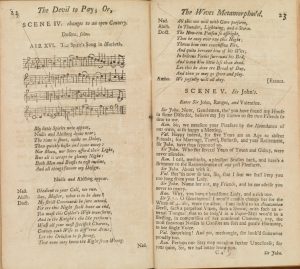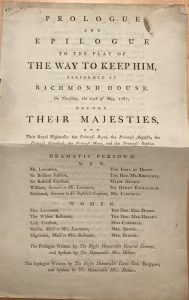19. Choice 11: Lady Diana Beauclerk’s Drawings for “The Mysterious Mother”
By Wilmarth S. Lewis
“Before 1962 when I was asked, ‘What would you most like to find?’ I answered promptly, ‘Lady Diana Beauclerk’s drawings for The Mysteriouos Mother.’ After praising Gibbon’s recently published Decline and Fall, Walpole asked Mason, ‘Do I know nothing superior to Mr Gibbon? Yes . . . I talk of great original genius. Lady Di Beauclerk has made seven large drawings in soot-water for scenes of my Mysterious Mother. Oh! such drawings! Guido’s grace, Albano’s children, Poussin’s expression, Salvator’s boldness in landscape and Andrea Sacchi’s simplicity of composition might perhaps have equalled them had they wrought all together very fine.’ High praise, but not a bit too high for Lady Di’s drawings. He wrote Mann, ‘Lady Di Beauclerk has drawn seven scenes of [The Mysterious Mother] that would be fully worthy of the best of Shakespeare’s plays–such drawings that Salvator Rosa and Guido could not surpass their expression and beauty. I have built a closet on purpose for them here at Strawberry Hill. It is called the Beauclerk Closet; and whoever sees the drawings, allows that no description comes up to their merit–and then, they do not shock and disgust like their original, the tragedy.’ Walpole described the Beauclerk Closet in an Appendix to the ’74 Description and bound the manuscript of it in Choice 8.
“‘[The Closet] is a hexagon, built in 1776, and designed by Mr Essex, architect, of Cambridge, who drew the ceiling, door, window, and surbase. . . . The closet is hung with Indian blue damask, and was built on purpose to receive seven incomparable drawings of Lady Diana Beauclerk for Mr Walpole’s tragedy of the Mysterious Mother. The beauty and grace of the figures and of the children are inimitable; the expression of the passions most masterly, particularly in the devotion of the countess with the porter,
“‘of Benedict in the scene with Martin,
“‘and the tenderness, despair, and resolution of the countess in the last scene; in which is a new stroke of double passion in Edmund, whose right hand is clenched and ready to strike with anger, the left hand relents.
“‘In the scene of the children, some are evidently vulgar, the others children of rank; and the first child, that pretends to look down and does leer upwards, is charming.’
“A writing-table of ‘Clay’s ware’ in the Closet contained ‘the play of The Mysterious Mother, to explain the drawings, bound in blue leather and gilt,’ a modest description of a beautiful book that is now at Farmington. Walpole wrote in it, ‘This copy to be kept in the Beauclerc Closet to explain Lady Di Beauclerc’s Drawings. H.W.’
“Where, I used to wonder, had these drawings got to? They were bought at the Strawberry Hill sale by Lord Portarlington, but his descendant to whom I wrote knew nothing about them. Then one morning in 1962 I walked into the back office of Pickering and Chatto’s shop in London where the proprietor, Dudley Massey, an old friend from 1925, as I tell in Choice 13, was expecting me. The drawings were turned over on his desk and were switched round so that Walpole’s notes on their backs were upside down. I stared at them, transfixed in the doorway, for I recognized them immediately. When I asked without moving, ‘What do you want for them?’ Dudley dropped a land mine. To my question at lunch, ‘Where did I go wrong?’ he answered promptly, ‘You asked the price too quickly,’ adding truthfully, ‘You would have given even more.’ One of the seven drawings is still missing, but those that Walpole described are now at Farmington.

“The Mysterious Mother, A Tragedy is set in the dawn of the Reformation; the scene is a castle, of course. There are two villainous friars, a faithful friend, a faithful porter, damsels, orphans, mutes. The plot turns on a double incest. Sixteen years before the play begins its chief character, the Countess of Narbonne, took the place of a girl she knew her son was about to seduce and now sixteen years later she fails to stop him from marrying their daughter. Byron called the play ‘a tragedy of the highest order, and not a puling love-play,’ and I agree with those who rank it above The Castle of Otranto as a work of art. Walpole tried to forestall possible criticism; but the subject, he said, was ‘so truly tragic in the two essential springs of terror and pity’ that he had to write it. To palliate the countess’s crime, and to raise her character he bestowed upon her, he tells us, ‘every ornament of sense, unbigoted piety, and interesting contrition.’ Although he protested that the subject was too ‘horrid’ for the stage, he hoped to see it acted; unfortunately, no one was up to playing the Countess and she has yet to be performed.*
“Walpole kept nearly all fifty copies of the play he printed at the Press. Those he gave away were eagerly read; five transcripts are at Farmington. In thirteen years he let Dodsley publish the play in London to forestall a pirated edition. Four more editions of it appeared before 1800, after which there was none until Chiswick Press brought it out in 1925 with The Castle of Otranto and and introduction by Montague Summers. The Mysterious Mother is known today only to student of eighteenth-century tragedy, a small audience.
“Seven copies of the Strawberry edition are at Farmington. On the most interesting one Walpole wrote, ‘With MSS alterations by Mr. Mason.’ In his ‘Postscript to the Alterations’ Mason wrote that they were ‘To make the foregoing scenes proper to appear upon the stage.’ Walpole thanked him with deepest gratitude, which he repeated years later, but what he really thought of the alterations is shown in his note written on Mason’s letter to him of 8 May 1769 (now at Farmington) that accompanied Mason’s alterations: ‘N.B. I did not adopt these alterations because they would totally have destroyed my object, which was to exhibit a character whose sincere penitence was not degratded by superstitious bigotry.’ Mason’s copy of the play was the Walpole item bought by Maggs in the Milnes Gaskell Sale of 1924. A dozen years later I discovered the new owner who obligingly took me to Messrs Robinsons’ in Pall Mall for me to see it. As he dropped me off at Brown’s Hotel afterwards he said, ‘I don’t care much about this book, but you want it so badly I think I’ll keep it.’ When death, the ally of collectors, took him away members of his family kindly turned the book over to me. Two of my letters to their relative, written on the Yale Walpole letter-head, were inside. They show that I had not yet learned to perform sedately the English gavotte of letter-writing, a clumsiness that has frustrated countless American scholars.
“In my Mellon Lectures Horace Walpole, 1960, I wrote of The Mysterious Mother, ‘the twentieth century has been initiated into the mysteries of the unconscious and needs no gloss on The Mysterious Mother, but one point should perhaps be noted for what it may be worth. When Walpole came to arrange his works for posthumous publication he printed his “Epitaph on Lady Walpole,” with its praise of her sensibility, charity, and unbigoted piety, immediately after The Mysterious Mother.'”
Lewis goes on to discuss other drawings by Lady Diana Beauclerk in the Lewis Walpole Library collection as well as the ebony Beauclerk cabinet. This is followed by a brief biographical sketch, including notes about her abusive husband, and a consideration of talented women and other amateurs. Lewis concludes his Choice 11 with “The discovery of talent in persons of quality whose gifts were generally unrecognized gave Walpole, the champion of the neglected, great pleasure. His gallery of well-born geniuses was assembled to do justice to their talents. At its head was Lady Di who had suffered so cruelly and had borne her lot with such fortitude and dignity.”
Lewis, Wilmarth S. Rescuing Horace Walpole. New Haven and London: Yale University Press, 1978.
To see the full chapter from Rescuing Horace Walpole called Choice 11: Lady Diana Beauclerk’s Drawings for “The Mysterious Mother” download or expand the link here:
 Loading...
Loading...
*N.B. The Lewis Walpole Library is staging an on-book reading of an abridged version of The Mysterious Mother on May 2, 2018, 5:30 pm, Yale Center for British Art Lecture Hall, 1080 Chapel Street, New Haven, CT. Open to the public.

















